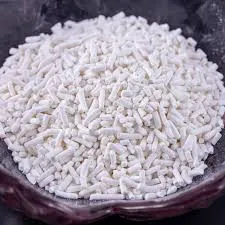
Properties and Applications of Formic Acid in Various Industries
Formic Acid (HCOOH) An Overview of Its Properties, Uses, and Applications
Formic acid, chemically represented as HCOOH, is a simple carboxylic acid that has garnered significant attention in various fields due to its unique properties and versatile applications. Derived from the Latin word formica, meaning ant, formic acid was first isolated from the body fluids of ants, leading to its prominent name. It is a colorless liquid with a pungent odor and is soluble in water, alcohol, and ether. The molecular structure consists of a single carbon atom double-bonded to an oxygen atom (carbonyl group), hydroxyl group (-OH), and a hydrogen atom, making it one of the simplest organic acids.
Physical Properties
Formic acid has a distinctive set of physical properties that make it an intriguing subject of study. The boiling point of formic acid is 100.8 degrees Celsius (213.4 degrees Fahrenheit), and its melting point is approximately 8.4 degrees Celsius (47.1 degrees Fahrenheit). These properties allow it to remain liquid at a wide range of temperatures, making it useful in varied applications. Formic acid is hygroscopic, meaning it can absorb moisture from the air, which contributes to its stability and usability in various industrial processes.
Production
Formic acid can be produced through several methods. The most common industrial technique involves the reaction of carbon monoxide with sodium hydroxide, followed by acidification. Additionally, it can be obtained from the hydrolysis of methyl formate or through the oxidation of methanol. The natural occurrence of formic acid in ants and other insects signifies its importance in nature, and small quantities can also be found in the leaves and fruits of various plants.
Applications and Uses
1. Agriculture One of the most notable uses of formic acid is in agriculture, where it acts as a preservative for silage, promoting the fermentation process and enhancing the nutritional value of fodder. It also serves as an ant and pest repellent, ensuring that crops remain healthy.
2. Leather Production Formic acid is widely employed in the leather industry for tanning. Its ability to denature proteins facilitates the preservation of animal hides and results in high-quality leather products.
formic acid hcooh

3. Chemical Syntheses In organic chemistry, formic acid serves as a crucial reagent in various chemical reactions. It is utilized in the production of numerous compounds, including methanol, acetic acid, and various esters. Formic acid's reactive nature allows for the formation of carbon-carbon bonds, making it a valuable precursor in synthetic chemistry.
4. Textiles The textile industry employs formic acid in dyeing and finishing processes. It helps improve the solubility and absorption of dyes, resulting in vibrant and enduring colors on fabrics.
5. Household Products Due to its acidic nature, formic acid is sometimes used in household cleaning products. It functions as an effective limescale remover and surface disinfectant, contributing to the maintenance of cleanliness in household environments.
6. Pharmaceuticals and Biochemicals In the pharmaceutical field, formic acid is used in various applications, including drug formulation and as a solvent in biochemical experiments. Its role in protein chemistry is particularly significant, as it assists in the denaturation and refolding of proteins for analytical purposes.
Safety and Environmental Considerations
Despite its wide range of applications, formic acid must be handled with care. It is corrosive and can cause irritation upon contact with skin or eyes. Inhalation of vapors can lead to respiratory distress. Therefore, appropriate safety measures, including the use of protective equipment, are necessary when working with this compound.
Formic acid is also regarded as a green solvent in certain applications, as it is biodegradable and can be derived from renewable resources. This environmental consideration aligns with the growing trend of sustainability in chemical processes.
Conclusion
In conclusion, formic acid (HCOOH) is a fascinating compound that plays a crucial role in various industries and applications. Its unique properties, along with its significance in agriculture, textiles, leather production, and pharmaceuticals, underscore its versatility. As industries increasingly seek sustainable alternatives, formic acid's biodegradable nature and potential for eco-friendly applications may help it retain its importance in the future.
-
The Safety Challenges of Ammonium Nitrate FertilizerNewsJun.26,2025
-
The Critical Role of Mining ChemicalsNewsJun.26,2025
-
Shelf Life of Glacial Acetic Acid Food GradeNewsJun.26,2025
-
Enhancing PVC Longevity with 1,2,3-Benzotriazole InnovationsNewsJun.26,2025
-
China’s Dominance in Food Additive ProductionNewsJun.26,2025
-
Can Aluminum Hydroxide Replace More Toxic Alternatives?NewsJun.26,2025
-
PE and PP Plastics with Benzotriazole AdditivesNewsJun.12,2025
Hebei Tenger Chemical Technology Co., Ltd. focuses on the chemical industry and is committed to the export service of chemical raw materials.
-

view more DiethanolisopropanolamineIn the ever-growing field of chemical solutions, diethanolisopropanolamine (DEIPA) stands out as a versatile and important compound. Due to its unique chemical structure and properties, DEIPA is of interest to various industries including construction, personal care, and agriculture. -

view more TriisopropanolamineTriisopropanolamine (TIPA) alkanol amine substance, is a kind of alcohol amine compound with amino and alcohol hydroxyl, and because of its molecules contains both amino and hydroxyl. -

view more Tetramethyl Thiuram DisulfideTetramethyl thiuram disulfide, also known as TMTD, is a white to light-yellow powder with a distinct sulfur-like odor. It is soluble in organic solvents such as benzene, acetone, and ethyl acetate, making it highly versatile for use in different formulations. TMTD is known for its excellent vulcanization acceleration properties, which makes it a key ingredient in the production of rubber products. Additionally, it acts as an effective fungicide and bactericide, making it valuable in agricultural applications. Its high purity and stability ensure consistent performance, making it a preferred choice for manufacturers across various industries.











